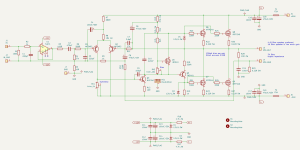Hi folks,
I have built SS guitar power amplifier based on Dr. Bora Jagodic amplifier Legend 100W.
I changed the circuit only by adding mixed-mode feedback to raise output impedance to about 24 ohms.
I have tested amplifier in rehearseal room and there is significant change in sound when amplifier is pluggen into 16 Ohms vs 4 Ohms.
Into 4 Ohms it sounds right, but into 16 Ohms there is too much bass and highs are rolled off too much.
What can be causing it? Oscillation?
Thanks for suggestions
I have built SS guitar power amplifier based on Dr. Bora Jagodic amplifier Legend 100W.
I changed the circuit only by adding mixed-mode feedback to raise output impedance to about 24 ohms.
I have tested amplifier in rehearseal room and there is significant change in sound when amplifier is pluggen into 16 Ohms vs 4 Ohms.
Into 4 Ohms it sounds right, but into 16 Ohms there is too much bass and highs are rolled off too much.
What can be causing it? Oscillation?
Thanks for suggestions
Attachments
Increasing the output impedance, you decreased the damping factor. Thus the cone resonance is remarked. Try returning the amp to its original design, or use only the speaker that sounds better for your taste.
Increased output impedance is done intentionaly.
I forgot to say, that I tested with 4x12 cabinet, which can be switched between 4 Ohms and 16 Ohms, all speakers in the cabinet are the same (Celestion Vintage30). The sound difference between two ohms settings is very big.
I forgot to say, that I tested with 4x12 cabinet, which can be switched between 4 Ohms and 16 Ohms, all speakers in the cabinet are the same (Celestion Vintage30). The sound difference between two ohms settings is very big.
Obvious. Also the amplification factor is different. With voltage feedback alone, the load value is irrelevant provided the amp is capable of manage it per se (current and voltage), but with current sensing, the load itself is part of the feedback network.
I understand negative current is intentional. I made a tube amplifier with positive current feedback reinforcing negative voltage feedback to reduce further the output impedance looking backward from the load into the amplifier. This really reduces the resonances of the cone to unbeliable limits, and I may still make output impedance negative.
I understand negative current is intentional. I made a tube amplifier with positive current feedback reinforcing negative voltage feedback to reduce further the output impedance looking backward from the load into the amplifier. This really reduces the resonances of the cone to unbeliable limits, and I may still make output impedance negative.
For the same sound as loaded with 4 Ohms, with 16 Ohms I would multiply the current sensor resistor by a factor of 4.I expected a some change in sound, but not this drastic.
That should work. So I will add another output jack(s) optimized for 8/16 ohm loads - speaker will go to ground through different current sensing resistor.For the same sound as loaded with 4 Ohms, with 16 Ohms I would multiply the current sensor resistor by a factor of 4.
It is to be expected, nothing wrong/oscillating, etc.Increased output impedance is done intentionaly.
I forgot to say, that I tested with 4x12 cabinet, which can be switched between 4 Ohms and 16 Ohms, all speakers in the cabinet are the same (Celestion Vintage30). The sound difference between two ohms settings is very big.
By changing load impedance you are changing the NFB network, so you are changing sound.
Said in other words as:
For the same sound as loaded with 4 Ohms, with 16 Ohms I would multiply the current sensor resistor by a factor of 4.
Please post actual circuit used, including speaker .
- Home
- Live Sound
- Instruments and Amps
- SS guitar poweramp, different sound when plugged into 4 or 16 Ohms
